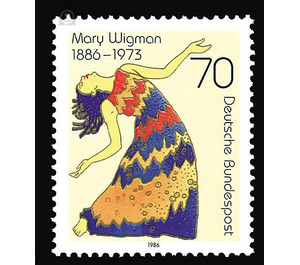100th birthday of Mary Wigman - Germany / Federal Republic of Germany 1986 - 70 Pfennig
Theme: Art & Culture
| Country | Germany / Federal Republic of Germany |
| Issue Date | 1986 |
| Face Value | 70.00 |
| Color | yellow |
| Perforation | K 13 3/4: 14 |
| Printing Type | 8-color offset |
| Stamp Type | Postage stamp |
| Item Type | Stamp |
| Chronological Issue Number | 1174 |
| Chronological Chapter | GER-BRD |
| Michel ID | BRD 1301 |
| SID | 999383 |
| In 36 Wishlists | |
On November 13, 1886, Mary Wigman was born in Hanover. However, the most important German dancer, choreographer and dance teacher of our century was registered in the birth register as Karoline Sofie Marie Wiegmann. The nickname Mary she received as a child, but the family name shortened in 1918 to Wigman. When asked why she had become a dancer, Mary Wigman once said, "Because dance is the liveliest life in its source and announces its life in its similiar reflections. I wanted to confess that to myself, with all the fibers of my being ". Mary Wigman came over the detour of the gymnastics to the dance. In 1910 she left Hanover and enrolled in the Rhythmic Educational Institute of Emile Jaques-Dalcroze in Hellerau near Dresden. The Swiss music educator had developed a novel method for training musical understanding and feeling through gymnastic exercises and offered vocational training in »rhythmic gymnastics«. Mary Wigman earned the teaching diploma, but was looking for personal dance forms of movement. In 1913 she left Hellerau and joined the dancer Rudolf von Laban, who maintained a "School for Art of Movement" during the summer in the life reformer colony of Monte Verita on Lake Maggiore and in winter in Munich and from 1914 in Zurich. The history of modern dance began in Germany when the two artistic personalities Mary Wigman and Rudolf von Laban met. Between 1913 and 1918, Mary Wigman developed the basics of her dance art in Switzerland as a pupil and assistant to Laban. In 1919 she returned to Germany. Opened in 1926 in Dresden, the school became a central location for the new dance, attended by students from all over the world. Mary Wigman's dance art was not based on certain rules of movement, as the classical ballet, but based solely on the organically natural movement possibilities of the body. For Mary Wigman as an external physical movement, dance was an expression of inner, psychic emotion. Influenced by the art flow of Expressionism, Mary Wigman gained free dance recognition as a serious art form during the 1920s. She was obsessed with the popular belief that the dance was only for graceful, easy conversation. Because dancing meant for her to represent life on a metaphysically elevated level, she was also considered the "high priestess" of German dance. She portrayed both the bright, lofty sides of life in her "solemn" dances, like the dark, dramatic ones in her "demonic" dances. Her most famous dances include the "Ceremonial Gestalt" (1925), the "Hexentanz" (1926), the "Feier" (1927/28) and the two cycles "Schwingende Landschaft" (1929) and "Opfer" (1931). The motif of the stamp comes from the "Autumnal Dances" (1937), the last solo dance cycle by Mary Wigman and shows one of her characteristic dance postures - a low back bow as a symbol of surrender to her as the law of life perceived principle of death and rebirth. After the seizure of power by the National Socialists in 1933, Mary Wigman was initially able to continue her artistic work unhindered, but was increasingly restricted from 1936 because her expressive, dramatic dance was no longer acceptable. In 1942 she had to give up her school and finish her dancer career. She moved to Leipzig and taught there at the College of Dramatic Arts. In 1945 she set up a school again in her private apartment and in the following years became involved in the reorganization of dance in the "SBZ". In 1949 she went to Berlin and opened in the western district of Dahlem her recognized as a vocational school "Mary Wigman Studio" in which she gave lessons up to her 80th year. During the fifties, she appeared several times with opera productions in Mannheim to the public and scored in 1957 with her choreography of Stravinsky's "Le Sacre du Printemps" in Berlin her last major choreographic success. Honored with numerous honors, Mary Wigman remained an active and passionate fighter for modern dance until her death on September 18, 1973 in Berlin as an art of free personal expression. (Text: Dr. Hedwig Müller, Cologne)
| Condition | Name | In Stock | Price | Price + Shipping | Store | |
|---|---|---|---|---|---|---|
 | Unmounted Mint ** | 100th birthday of Mary Wigman - Germany / Federal Republic of Germany 1986 - 70 Pfennig | 10 | US $0.748 | US $3.94 |  FILATELIELOKET (0) FILATELIELOKET (0)Shipping US $3.19 Minimum Order US $2.67 |


